The Timeline is the most interesting & awaited feature in Windows 10. Once enabled, this feature will keep track of what you have been doing on your Windows 10, the files you access, browsers, folders, apps, and so on. Imagine this has your browser’s history, which keeps track where you have been, and you can jump back right away to that particular app or file from there.
Windows 10 Timeline feature
Once you have upgraded your Windows 10 to Spring Creators Update, you will see a new icon right next to the search box. It will look like a couple of small rectangles stacked on top of each other. Click on that.
Don’t be surprised if you see a blank screen with Multi-Desktop access on top. Timeline becomes effective with time as you use your PC for some time.
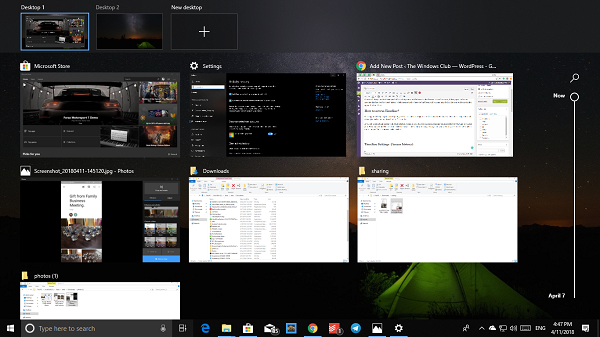
The best time to check back on Time will be after a day of usage, and you will be surprised to see how much it tracks for you.
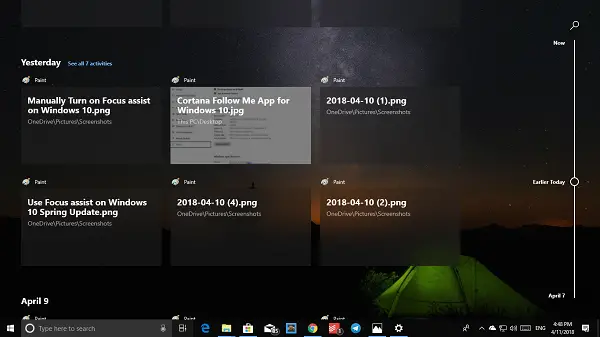
Now, if you are guessing that its almost like Task View which was available in Windows 10 Creators Update, then you got it right. The Access History, Task View, Timeline features have all are now combined into one.
Timeline Settings (Access history)
The timeline goes one step ahead. If you have multiple PCs, and your files stay in the cloud, you can access them from any PC with your account. The timeline can sync activities between PCs by syncing to cloud and making it available on another PC. Personally, it’s my favorite feature as I can now truly pick up from where I had left my work.
Go to Settings > Privacy > Activity History. Here you can choose to disable timeline syncing activities to the cloud, and you only get to see them on the same PC, and nowhere else. Microsoft also restricts activity history logging to last four days instead of 30 days when you choose to turn off cloud sync.
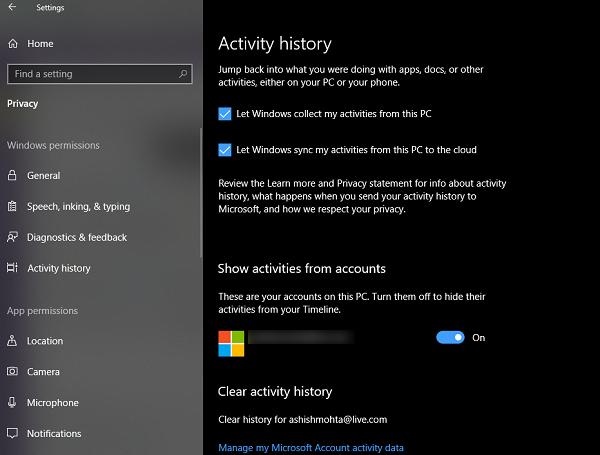
If you have multiple accounts on the PC, you can choose to turn off Timeline for those accounts.
How to remove items from Timeline in Windows 10
The Timeline allows you to remove whatever you don’t want it to remember. When it a timeline, for apps, just hover your mouse over the top-right corner of that listing, and you should see an option to close. Interesting to note that while you can close the apps, you cannot remove them.
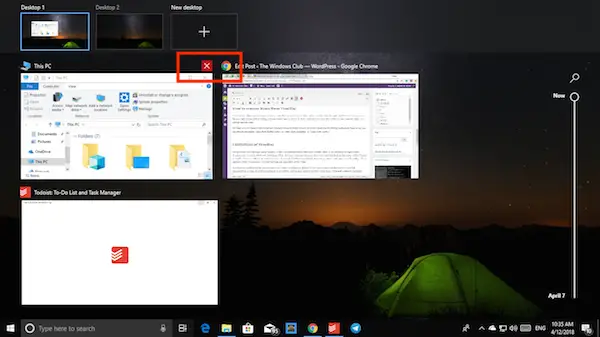
For files, you will have to right-click and choose to remove. If you want to remove a particular file listing particularly from a day, you can choose the option “clear from Earlier today” or “clear from yesterday” or “clear from April 9”.
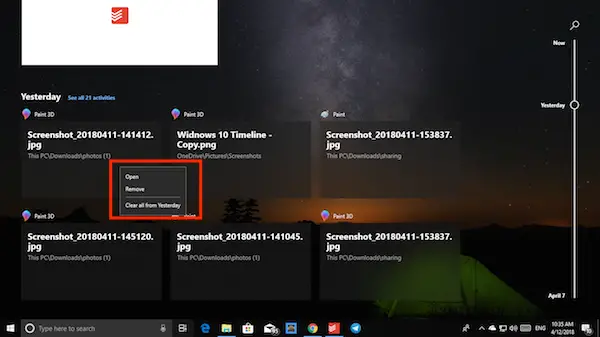
When you have more than 6 activities in a timeline, you get a link on the timeline which will be labeled as “See all 21 activities”. Click on that, and it will expand to a detailed timeline showing you activities from every hour. You can also choose to view only top activities to go back.
TIP: This post will show you how to hide Suggestions in Timeline.
Disable Windows 10 Timeline feature
To disable Timeline, open Settings > Privacy > Activity History. Here uncheck Let Windows collect my activities from this PC.
Timeline & Multiple/Virtual Desktops
Microsoft has implemented Timeline in such a way that each desktop gets its own Timeline. The only thing common between all timelines is they share files between them. So doesn’t matter on which desktop you had opened the file, it will show on all timelines. However, the apps are restricted to individual desktops.
When you right-click on any of the apps, when on the timeline, you get the following options:
- Snap apps right and left.
- Move Apps to a different desktop.
- Show this window on all desktops
- Show windows from this app on all desktops.
While the first two are straightforward, the last two one needs a bit of explanation. When you choose to Show this window on all desktops, the app will become available on all desktops. This is like pinning the apps to be available on all desktops, and it doesn’t switch the desktop automatically.
If you choose Show windows from this app on all desktops, then other instances of the app will also become available on app desktops. Let’s take Edge as an example here. If you have multiple instances of Edge open in one desktop and have “Show this window on all desktops”, then those instances will not be available there, but as soon as you enable the Show windows from this app on all desktops option, all those will also become available.
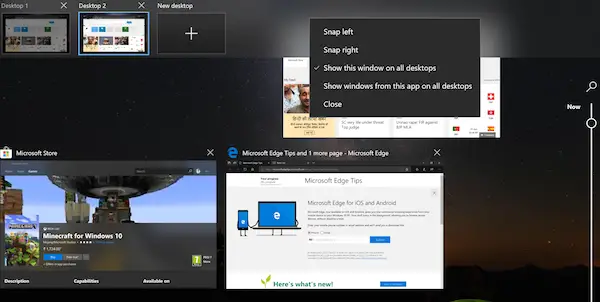
On Desktop 2, I have two instances of Edge. While on Desktop 1, I have one. After I enable the second option, all the instances of Edge become available on Desktop One as well.
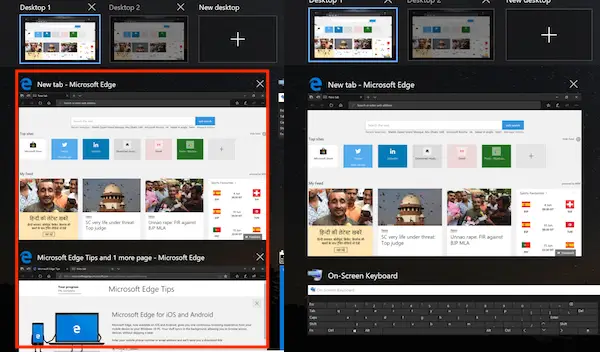
If all this sounds familiar to you, then you are right. Virtual Desktop features are part of the timeline now.
NOTE: In Windows 11, Microsoft has removed the Timeline feature.
Limitations of Timeline feature
The timeline works better with Microsoft products or apps from the store. If you use Firefox or Chrome as your default browser, Timeline may not accurately track it. It will be the same with PDF readers or another category of software. Windows Store apps, however, are tracked properly.
I hope you enjoy using this new feature.
This post may help you if the Timeline feature is not working in Windows 10.
I have done an inplace upgrade with media creation tool to 1803 april update and the timeline doesn’t work on my pc. Everything is enabled but it doesn’t collect anything. Any way to fix this?
Same here, upgraded through Windows Update, Timeline worked once and then stopped working after I restarted my PC. Clicking the taskbar button or using WinKey+Tab doesn’t do anything.
Isn’t working for me either (on 1803 through Windows update), with everything enabled.
Does this help? https://www.thewindowsclub.com/timeline-feature-not-working-windows
Anand, creating the three registry keys (which weren’t present although my privacy settings were OK) and setting them to 1 seems to have done the trick. Thanks.
OK, scratch that. It worked fine yesterday, now it doesn’t. I checked and the registry keys are still there, but taskbar button or keyboard shortcut do not work anymore.
There’s definitely a bug there.